Contents
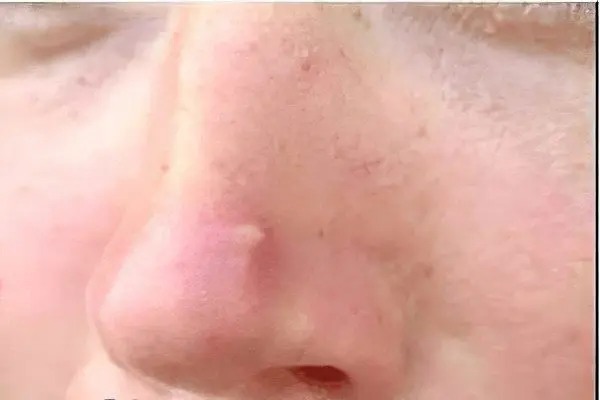
Acne is a common problem that every person has faced at least once in their life. They can appear anywhere, but are most commonly found on the face, back, and chest. Acne is an inflamed area of the skin. An inflammatory reaction develops due to the fact that the sebaceous glands are clogged with a skin secret.
Acne that occurs at a young age often causes severe psychological discomfort. Often, skin rashes appear in adults. Therefore, it is impossible to consider this problem exclusively teenage.
Acne – what is it?
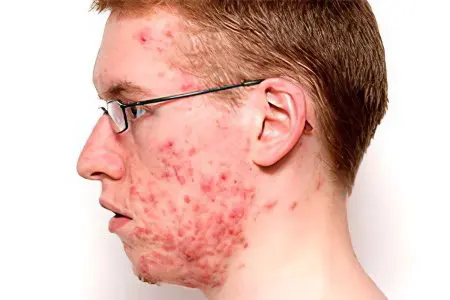
Acne is the result of blockage of the sebaceous glands. They become clogged with sebum and particles of dead epidermis. Such conditions are ideal for the reproduction of bacteria. Pustules become a visible manifestation of inflammation. In adolescence, acne is a variant of the norm. It develops due to hormonal changes in the body. Acne is caused by both internal and external causes.
Internal causes that lead to the formation of acne:
Hormonal imbalance in the body. An increase in the number of acne is observed in women and girls before the next menstruation.
Decreased immunity.
The presence of chronic diseases. Often, ovarian diseases lead to acne in the chin area.
Diseases of the digestive system and liver.
Infections.
Seborrhea.
Burdened heredity. In this regard, the activity of the sebaceous glands, their size and number are important. Often acne becomes a problem of blood relatives.
External causes that can lead to acne:
The interaction of the skin with substances that have a comedogenic effect. They lead to the fact that the sebaceous glands become clogged, and the skin becomes rough. An example of such substances can be oil, grease, preparations with tar. Sometimes people suffer from acne due to the peculiarities of their professional activities.
The use of cosmetics that contain a fatty component. This is true for powder, blush, suntan oils.
Prolonged exposure to the sun, the use of greasy creams to protect against ultraviolet radiation.
Friction of clothes on the skin against the background of excessive sweating of a person. Dermal injury.
Insufficient personal hygiene. Poor or infrequent use of exfoliators can cause the epidermis to clog the sebaceous glands.
Taking hormonal drugs, steroids.
Frequent stress, which leads to increased work of the adrenal glands and the release of excess hormones into the blood.
Acne does not form all at once. This process goes through several stages: the sebaceous glands secrete an excess amount of secretion, the skin layer thickens, bacteria become active, and inflammation develops.
Mechanism of acne development
Blockage of the sebaceous glands leads to the appearance of acne. They increase in size due to increased separation of sebum. Skin pores, which normally should not be visible, expand and become visible. At the mouth of the gland, the stratum corneum of the epidermis thickens, as the skin begins to peel off more often. Dead cells completely clog the duct, sebum ceases to be excreted, the gland is stretched. In such conditions, bacteria quickly begin to multiply. They are always present on the surface of the dermis, but do not show pathological activity until favorable conditions are created for this. As a result of these processes, inflammation develops.
Comedo is a term that characterizes an inflamed gland filled with sebum. The inflammatory secret cannot come out, it remains under the skin and turns into white acne. Sometimes acne is black. This happens when the comedone breaks through the surface of the skin, oxidizes, mixes with melanin, which causes its characteristic color.
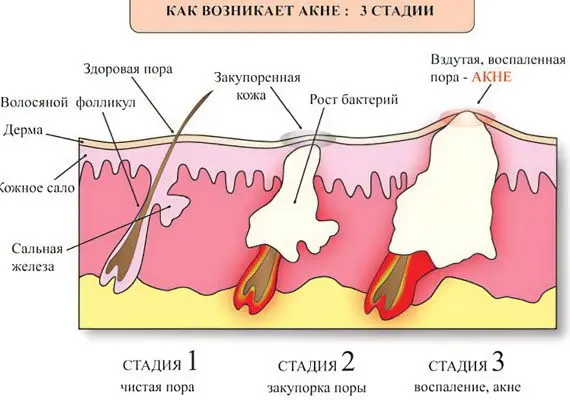
Classification of acne
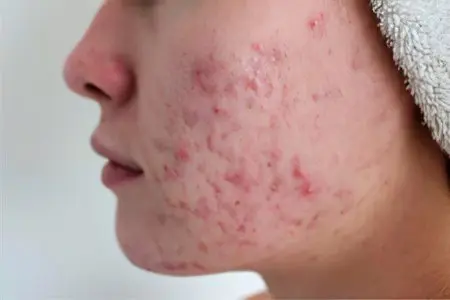
Depending on the severity of the course of the disease, there are several degrees of acne:
Light severity. There is no inflammation, but it is noticeable that there are comedones, pustules and papules on the dermis. There are few of them, the total number of rashes does not exceed 10 pieces. The therapy is not difficult.
Moderate degree. The number of comedones of closed and open type is 10-25 pieces, there are also many acne. Therapy in this case will last at least 2 months. The prognosis for a complete restoration of the dermis is favorable.
Severe degree of acne. There are multiple rashes on the skin, their number can be 30-50 pieces. Complex therapy is required to cope with acne.
Extreme severity. The patient’s skin is covered with papules, pustules, nodules, cysts, comedones. The therapy is complex and lengthy, it will not be possible to cope with the violation on your own.
If a person has multiple rashes on the skin, then they should not be ignored. Self-medication can lead to a worsening of the course of the disease.
Types of acne
Acne can be of several types. There are various reasons for their formation.
Varieties of acne:
Acne vulgaris
Whiteheads (miliums)
Rosacea (rosacea)
Blackheads (comedones)
Steroid acne
Acne conglobate
Subcutaneous acne
Acne vulgaris
Most often, acne vulgaris appears in adolescence. As a rule, closer to 20 years they pass. Rarely, acne vulgaris occurs in adults. They can be the result of a violation in the functioning of the organs of the digestive system, the liver. Sometimes they are caused by endocrine disorders.

At the initial stage of acne formation, the skin is covered with small red spots. They are opened, and in their place a purulent cavity is formed. After such acne, scars and scars remain on the dermis, skin pigmentation changes.
Acne vulgaris appears on the face – this is their favorite place of localization. Sometimes rashes cover the skin of the back and chest.
The main cause of acne vulgaris is a hormonal imbalance. Often this problem can be traced in blood relatives, which indicates the influence of the factor of heredity. Other causes of acne vulgaris include: nutritional errors, improper skin hygiene, parasitic damage to the dermis.
Whiteheads (miliums)
Milia are whiteheads that appear due to excessive work of the sebaceous glands. Whiteheads can develop due to exposure to the skin of any traumatic factors, for example, when ultraviolet radiation hits it in excess. They can also be provoked by internal inflammatory processes occurring in the body.
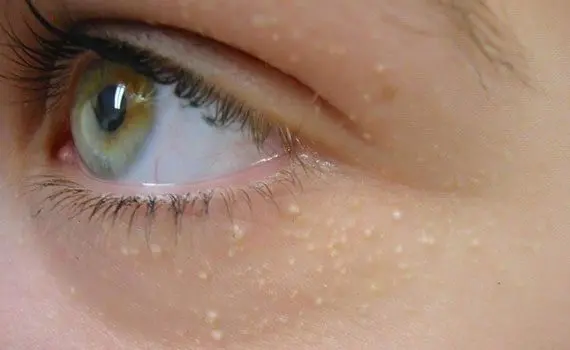
Whiteheads do not reach large sizes, their average diameter is 2-3 mm. They are quite dense, have a yellow color, and look like grains. Often such acne appears on the temples, on the nose, on the cheeks, around the eyes. They can be single or multiple.
A whitehead is, in fact, a collection of sebum that is in a pore and has no way to get out. The head of the eel is white as it shows through the dermis.
It is impossible to exclude such causes of the development of white acne as: hormonal imbalance, poor-quality skin hygiene, diseases of the digestive system. Many people ignore the appearance of whiteheads, delaying treatment. Doing so should not be done as it may exacerbate the problem.
Rosacea (rosacea)
Rosacea most often appears on the skin of people who have crossed the age limit of 30 years. They are accompanied by the formation of papules, which later fester. Most often, women suffer from this problem.
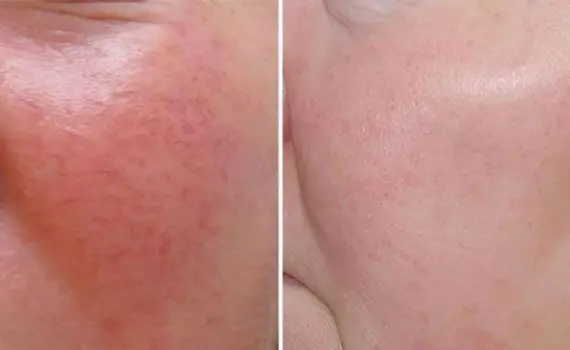
Symptoms of rosacea:
Skin hyperemia. The forehead, nose, cheeks, chin become red. Acne can spread to the chest and back.
The appearance of a red rash on the skin. Over time, it transforms into acne.
Skin tightening. This occurs in the late stages of the development of the disease.
Vasodilation. The vascular network shines through the dermis.
In the eyes there is a feeling of sand or other foreign body. Tearing increases, the whites of the eyes turn red.
Blackheads (comedones)
Blackheads appear on the skin without a preliminary inflammatory reaction. Most often they form on the nose, on the forehead, on the chin and on the cheeks. Rarely, blackheads are found on the back and on the chest.
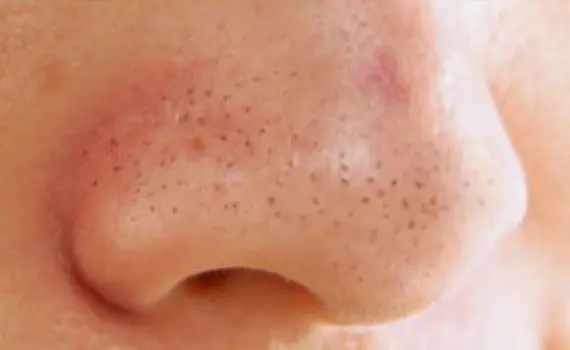
Provoke the formation of comedones can be hormonal disruptions, disorders in the ovaries or thyroid gland, eating fatty or carbohydrate foods.
To cope with the problem, cleaning of the skin is required. However, such a procedure is not enough for a long time, it will need to be systematically repeated. With age, the activity of the sebaceous glands decreases, so blackheads rarely appear on the skin.
Steroid acne
These eels look extremely unaesthetic. This is where their main harm lies. Steroid acne appears on the dermis due to treatment with steroid drugs. Their cancellation allows you to cope with rashes. The main problem is that it is not always possible to refuse the drug.
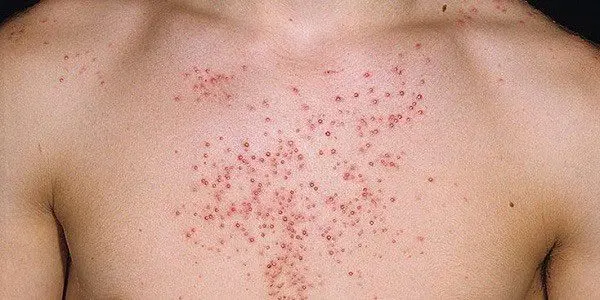
Steroid acne looks like small pustules that are bright red in color. They can cover the entire body, or a certain part of it. Sometimes acne is concentrated only in the place where a person applies a hormonal drug.
Acne conglobate
Such eels are spherical in shape, they appear on the arms, legs, neck and back. Acne is located deep in the subcutaneous fat layer of the dermis. Sometimes they respond with severe pain and have a blue-purple color. There is a pustule in the center of the eel. Conglobate rashes can appear on the cheeks, on the chest, on the neck and on the back. Most often, men suffer from them, age does not matter.
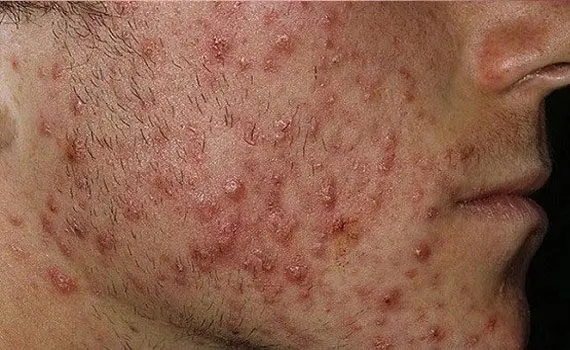
Violations such as:
Stress, emotional overload, depression.
Hormonal imbalance, diabetes mellitus, disturbances in the functioning of the endocrine glands.
Infectious diseases that have a chronic course.
Excess iodine and bromine in the body.
Treatment with certain drugs.
Smoking, external negative factors.
The skin over the acne is uneven, and after they heal, scars may remain on it.
Subcutaneous acne
Such acne can appear both in an adult and in a teenager. Subcutaneous acne is formed due to excessive accumulation of pus against the background of inflammation of the sebaceous glands. The back and shoulders, neck, face and chest suffer most often.
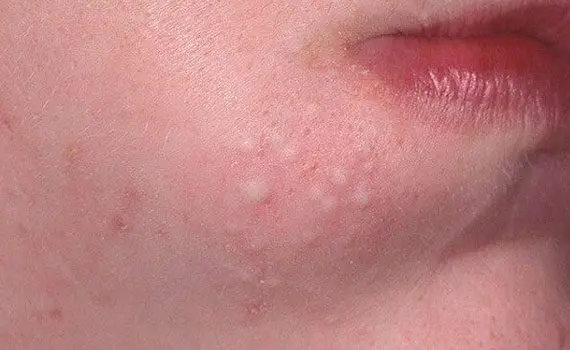
Acne is white in color because it contains pus. The eel is bordered with a red rim. It is represented by an area of inflamed skin.
Causes of subcutaneous acne:
Hormonal imbalance in the body.
Violations in the work of immunity.
Diseases of the digestive system.
Subcutaneous mite infestation.
Diseases of the liver.
Nutritional errors.
Increased sweating.
Hereditary predisposition.
Chronic illnesses.
When a pimple is located under the skin, it is difficult to squeeze it out. At the same time, the appearance of a person worsens to a large extent, the dermis becomes unattractive. If you try to squeeze out a subcutaneous acne on your own, this can lead to severe skin damage and even blood poisoning. After such manipulations, scars may remain on the face and other parts of the body.
Treatment
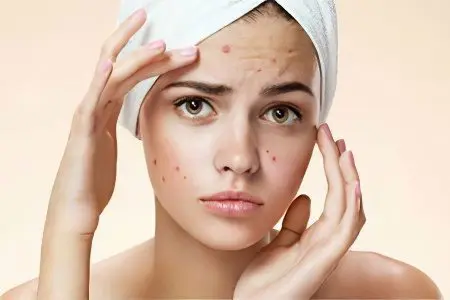
To get rid of acne, you need to establish the cause of their appearance on the skin. In this case, consultations of such narrow specialists as: endocrinologist, dermatologist, gastroenterologist, gynecologist may be required.
Blood and urine are taken from the patient for analysis, the biochemical composition of the blood is examined, and the level of hormones in the body is assessed. It may be necessary to donate feces for dysbacteriosis, sometimes the patient is prescribed an ultrasound of the internal organs.
If acne is mild, then the doctor may recommend topical skin treatments: gels, ointments, lotions, creams. They contain substances that allow you to fight acne, dry the skin, reduce secretion, and eliminate the inflammatory reaction. To cope with such problems, tools that contain tretinoin, benzoyl peroxide, azelaic acid, etc.
If the disease has a severe or moderate course, then antibiotics are required. Sometimes they carry out therapy that allows you to stabilize the hormonal background in the body.
If acne has a running course, then its elements are eliminated mechanically. The procedure is carried out in a cosmetology room. The skin is cleansed with peels. Massage, cryotherapy, laser therapy sessions are also carried out.
Timely initiation of treatment will avoid serious problems. Therefore, when acne appears, you need to consult a doctor. This will make it possible to preserve the beauty and health of the skin of the face and body.
[Video] Dr. Berg – HOW TO GET RID OF ACNE?









